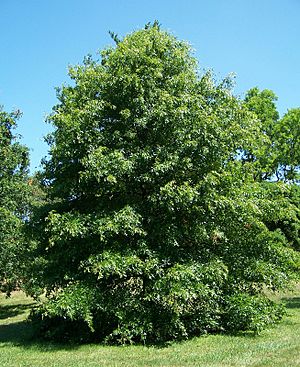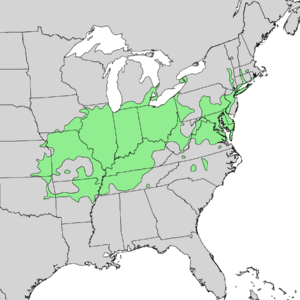Pin oak facts for kids
Quick facts for kids Pin oak |
|
|---|---|
 |
|
| Conservation status | |
| Scientific classification | |
| Genus: |
Quercus
|
| Species: |
palustris
|
 |
|
| Synonyms | |
|
|
The Pin Oak (scientific name: Quercus palustris) is a type of oak tree. It belongs to the red oak group. People often use pin oaks in landscaping because they are easy to plant, grow fairly quickly, and can handle pollution well. Its unique shape makes it stand out from other hardwood trees.
Contents
What Does a Pin Oak Look Like?
The pin oak is a medium-sized tree that loses its leaves in the fall (it's a deciduous tree). It usually grows about 18 to 22 meters (60 to 72 feet) tall. Its trunk can be up to 1 meter (3 feet) wide. The branches can spread out 8 to 14 meters (26 to 46 feet). A young pin oak, about 10 years old, will be around 8 meters (26 feet) tall.
Young vs. Mature Trees
When pin oaks are young, they have a straight trunk with smooth bark. Their branches form a pyramid shape. As the tree gets older, usually around 40 years, its bark becomes rougher. The branches spread out more. The way its branches grow is very special:
- The top branches point upwards.
- The middle branches stick out straight.
- The lower branches hang downwards.
Pin Oak Leaves and Acorns
The leaves of a pin oak are about 5 to 16 centimeters (2 to 6 inches) long and 5 to 12 centimeters (2 to 5 inches) wide. They have five or seven deep, rounded sections called lobes. Each lobe has tiny, pointy tips. The spaces between the lobes are very deep, almost as big as the leaf parts themselves. The leaves are mostly smooth, except for a small tuft of fuzzy, orange-brown hairs where the veins meet in the middle. In autumn, the leaves usually turn a bronze color.
The acorns grow in a shallow cap. They are round on the bottom, about 10 to 16 millimeters (0.4 to 0.6 inches) long and 9 to 15 millimeters (0.35 to 0.6 inches) wide. They start green and turn light brown about 18 months after the tree is pollinated. Pin oak acorns are very bitter and not good to eat unless they are specially prepared.
Where Pin Oaks Grow Naturally
Pin oaks grow quickly and are often found in wet areas like wetlands. They have shallow roots, unlike many other oaks that have deep main roots. They prefer acidic soils and do not grow well in limestone or sandy soils. They are found at low elevations, up to about 350 meters (1,150 feet) above sea level. The scientific name palustris means "of swamps," which describes their natural home.
Leaves in Winter
One interesting thing about young pin oaks is that they often keep their dead leaves on their branches all winter. This is called marcescence. The leaves die in the fall but stay attached until new leaves grow in the spring. This usually happens on trees shorter than 6 meters (20 feet). Like many other oak trees, dead pin oak branches can stay on the tree for many years.
What's in a Name?
The scientific name for the pin oak is Quercus palustris. The word palustris comes from Latin and means "of marshland." This name perfectly describes where these trees naturally like to grow: in wet, swampy areas.
Where Do Pin Oaks Live?
Pin oaks are mostly found in the eastern and central parts of the United States. Their native range stretches from Connecticut in the east to eastern Kansas in the west. To the south, they grow down to Georgia and western Oklahoma. They are also native to the very southern part of Ontario, Canada.
Pin oaks have also been planted in other parts of the world. They grow well in Australia, especially in cooler southern states like Victoria and New South Wales. They also thrive in South Africa and Argentina.
Pin Oak Homes
Pin oaks mostly grow on flat or almost flat land that doesn't drain well. This includes floodplains and river bottoms with a lot of clay in the soil. They are usually found in places that flood sometimes during the winter, but not usually during the growing season. They don't grow in the lowest, wettest spots that might have standing water for most of the year.
However, they also grow a lot on poorly drained "pin oak flats" in places like southern Ohio, Illinois, Indiana, and northern Missouri. These areas have flat land and a layer of clay in the soil, which makes them very wet in winter and spring.
Reproduction and Life Cycle
Like all oaks, pin oaks produce flowers and leaves in the late spring, after all danger of frost has passed. Their flowers are called catkins. Each tree has both male and female flowers, but they can't pollinate themselves. They need another oak tree nearby for pollination to happen. Any oak from the red oak group can help pollinate a pin oak. In nature, this is often a northern red oak or scarlet oak. Different types of oaks can also cross-pollinate and create hybrid trees.
The acorns of a pin oak take two full growing seasons to develop before they are ready.
How Pin Oaks Compete with Other Plants
Pin oaks don't like a lot of shade. They are less tolerant of shade than trees like elm or sweetgum, but they can handle more shade than eastern cottonwood. Pin oaks usually grow in groups where all the trees are about the same age and height. Smaller, weaker trees in these groups often die quickly if they get overshadowed. A single pin oak growing among other types of trees is usually one of the tallest.
Pin oaks are also known to be allelopathic. This means they produce chemicals that can stop other plants from growing nearby, helping the pin oak to survive and thrive.
What Can Harm Pin Oaks?
Pin oaks can handle flooding very well when they are not growing (in winter). However, they don't do as well with flooding during the growing season. If they are flooded off and on for several years in a row during the growing season, the trees can get hurt or even die. They can usually survive one full growing season of continuous flooding, but two or three years in a row will kill them.
Because their bark is quite thin, pin oaks are easily damaged by fire. Fire wounds can also lead to decay in the tree.
How People Use Pin Oaks
In the areas where it grows naturally, the pin oak is one of the most popular trees for landscaping, along with the northern red oak. This is because it's easy to move and plant, grows fairly fast, and can tolerate pollution.
However, pin oaks naturally like moist, acidic soils. If they are planted in less suitable places, especially in alkaline (not acidic) soil, they can get a problem called iron chlorosis. This makes the tree lose its leaves during the growing season and start to rot from the top down. Large, mature pin oaks are often too big to treat for this problem, and it can eventually kill them. Also, the lower branches of pin oaks droop downwards, which can sometimes get in the way of people or traffic.
Pin oaks are also grown in parks and large gardens in the United Kingdom. The Royal Horticultural Society has given it an Award of Garden Merit, which means it's a great garden plant.
The wood of the pin oak is often sold as "red oak," but it's not as strong and often has many small knots. The wood is hard and heavy. People use it for general building and for firewood. Some Native American tribes used the bark to make a drink to help with stomach pain.
The name "pin oak" might come from the many small, thin twigs on the tree. Or, it could be because the hard wood was historically used to make wooden pins in building construction.
The pin oak is the only known food plant for the caterpillars of a tiny moth called Bucculatrix domicola.
Similar Trees
Because their leaves look similar, pin oaks are sometimes confused with scarlet oak and black oak, and sometimes even red oak. However, you can tell a pin oak apart by its unique crown shape and the dead branches that often stay on the lower part of the trunk (the "pins"). Also, the spaces between the lobes on pin oak leaves are very deeply cut, often taking up as much space as the leaf itself.
Images for kids
See also
 In Spanish: Roble palustre americano para niños
In Spanish: Roble palustre americano para niños








